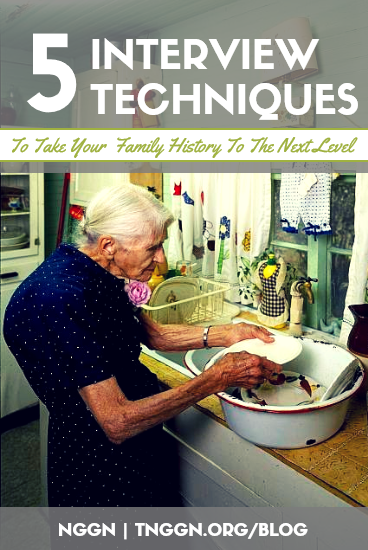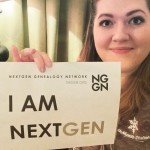Author: admin
DNA and the Next Generation
July 20, 2015
Genetic genealogy has become an essential tool for genealogists. With more than two million people tested to date, genealogists use DNA evidence every day to confirm research, study ancient roots, and break through brick walls.

In addition to breaking brick walls, genetic genealogy is also breaking social barriers. DNA testing engages both genealogists and non-genealogists of all ages, young and old. It shows us with scientific certainty just how closely related we all are, regardless of our age, location, history, ethnicity, or creed. Genealogists interested in engaging a younger generation can exploit this powerful aspect of DNA.
There are many reasons to encourage the next generation to investigate DNA testing. First and foremost, it is a great way to get younger test-takers interested in genealogy. With a bit of elbow grease, the results of a DNA test reveal the random tendrils through time that physically connect us to our ancestors and family history. Indeed, another reason to investigate DNA testing is simply because it is an essential source of evidence for genealogical research.
Younger test-takers often benefit more from the results of testing more than older generations. DNA is taught in biology class from a young age, and students have extensive experience with computers, so there is a minimal learning curve. Additionally, younger test-takers typically have more living ancestors (parents, grandparents, maybe even great-grandparents) and older relatives they can test in order to reveal even more information about their family history.
Educators who recognize the engaging power of genetic genealogy can use DNA testing in the classroom to explore topics in history, biology, and social studies. As early as 2007, for example, the National Genographic Project donated 750 kits to students in Chicago Public High Schools and 250 kits to sister schools in England. The students used the results of the Y-DNA and mtDNA testing to study human migratory patterns and to discover just how related they all are. “It’s like I’m related to everyone I know,” said one of the students. There is great untapped potential to use genetic genealogy testing to educate and engage students.
To understand the motivations and genealogical interests of younger test-takers, we created a short survey for test-takers who had taken their first DNA test prior to the age of thirty. The survey asked questions about why they took a genetic genealogy test, how they were introduced to DNA testing, what result of the testing was the most interesting, and how DNA testing affected their interest in genealogy, among other questions.
The results of the survey provide important insight to genealogists. For example, 56% of young test-takers took a genetic genealogy test to learn about their ethnicity and general ancestry, compared to 19% who took the test to answer a specific genealogical question, 11% to learn about their health, and 6% because of adoption or unknown paternity (the remaining 8% having some other reason for testing). In some ways, the results are not surprising. Ethnicity results have been the focal point of much of the recent advertising by genetic genealogy testing companies like 23andMe and AncestryDNA, likely the result of marketing research that recognized the public’s interest in those types of results, and almost half of respondents were introduced to genetic genealogy through an advertisement. However, of those who originally tested in order to learn more about their ethnicity, almost half reported being more interested in another aspect of their actual results. Although ethnicity brings test-takers in the door, genealogists can subsequently maintain interest by introducing tested individuals to other pertinent aspects of family history.
Another very important result was obtained in response to the question about whether the test-taker’s interest in genealogy increased, decreased, or stayed the same after they took a DNA test. Although 38% reported that it stayed the same, 62% reported that their interest in genealogy increased after DNA testing. And just as important, not a single respondent reported a decrease in interest. The results suggest that DNA testing offers genealogists an unparalleled opportunity to increase interest in genealogy among younger test-takers.
Whether in the classroom or with a grandchild, DNA testing offers genealogists a unique opportunity to engage younger test-takers. With genetic genealogy becoming increasingly ubiquitous, these opportunities will abound. Hopefully we will recognize and embrace this chance to engage the next generation.
Blaine Bettinger, Ph.D., J.D., is an intellectual property attorney by day and a genetic genealogist by night. He is the author of the long-running blog The Genetic Genealogist, and frequently gives presentations and webinars to educate others about the use of DNA to explore their ancestry.
Paul Woodbury is a recent graduate of Brigham Young University where he studied genetics and family history. Currently he works for Legacy Tree Genealogists as a client researcher with specialties in French, Spanish, Italian, Scandinavian, and genetic genealogy. He frequently presents on these and other research topics at family history conferences.
Faces of NextGen: Meet Michael Melendez
July 13, 2015
 Michael Melendez, 25, Utah
Michael Melendez, 25, Utah
What five words would you use to describe yourself? Shy, old soul, unorthodox, observant, ambitious.
Why genealogy? Because it brings family stories and historical events into cohesion.
What’s the coolest discovery you’ve made? That NextGen exists!
What are you working on this week? The Southern California Genealogical Society Jamboree.
What’s the number one secret to your success in genealogy? Gleaning more information from a record than the average person.
What superpower would you want to help you uncover your family history? Time travel.
What are we most likely to find you doing when you’re not researching family history? Political activism.
The NextGen Genealogy Network is made up of young genealogists with diverse backgrounds, interests, and experiences. Faces of NextGen will showcase a different member of our community each month. If you would like to be considered for an upcoming feature, simply complete our questionnaire and submit a selfie.
Education Hangout: Getting a Genealogical Education
June 22, 2015
It’s time to talk about a genealogical education: what it is, where it is, and how you can get it. Did you know there are countless opportunities to learn online from the comfort of your own couch? Shannon Combs Bennett of the NextGen Genealogy Network’s Leadership Team shares details for anyone who wants to boost their skills as a genealogist in the June Education Hangout:
Don’t forget to bookmark our YouTube Channel and listen in for fantastic, friendly advice on a variety of topics relevant to the young genealogist!
5 Interview Techniques to Take Your Family History to the Next Level
June 15, 2015
You probably already know that conducting an interview with a family member can help to paint a more complete picture of your family history. What you may not know is some of the techniques that the pros use to make sure that the interview is productive and results in a useful addition to available historical records. Here are my top five suggestions to help you make the most of your interview:

1. Preparation is key. It can be tempting, especially if the interviewee is someone you know well, to simply show up and chat over cookies. While that can be lovely, if you want a fruitful interview, it helps to be a little more formal in your technique. By preparing questions in advance and researching the places, time periods, and events that that person may have experienced, you in essence create a roadmap to follow. It also allows you to try to constrain the time of your interview and to decide if you might need more than one session. The ideal length for an interview is between forty-five minutes and an hour and a half.
2. Think of yourself as a tour guide. A tour guide wants visitors to enjoy their experience, lingering at a specific point of interest and discovering hidden treasures they may not have seen before. But the other important aspect of guiding a tour is knowing how to keep your group on track. Just like a tour guide, you do not want to interrupt or cut short a discussion that may reveal something important or unexpected. However, all interviews will get off track without some mild steering from the interviewer. The easiest way to do this in most cases is to wait for a breaking point and say something like, “That is very interesting. I would love to talk more about that a little later. Do you mind if we talk about ______ for a moment first?” Usually, a question like that will draw your subject back onto the path.
3. Work chronologically at the beginning. For every interview I begin asking questions chronologically. Typically, memories from our youth are strongest in our mind because when they occurred there was less information competing for a coveted spot in our long-term memory. By beginning with memories that are more vivid, it allows the interviewee to get excited about the experience and feel a sense of fulfillment and accomplishment at being able to answer questions in a complete and informative way. It is also important to be flexible to changing this as your interview goes on. If a question provides a natural transition to another topic that you want to cover, you may want to move out of chronology to cover it.
4. Learn to recognize nervousness. I have interviewed people who have spouted off two decades worth of history before I have even managed to get my recorder out of my bag, and others who sit silently for several minutes after each question. Both behaviors are signs of nervousness. If you notice one of these, it is a good idea to adapt your technique or ask about something that will get them more relaxed. In most cases, people love talking about their children, their childhood, and especially their pets, and when they are enjoying their memories they will often forget you are even there.
5. Know when something is not working. One of my first interviews was with a woman who was well over one hundred years old and who struggled to answer questions. On my way out of our first session, I noticed that in her foyer was a wall adorned with beautiful oil paintings from her travels. For our next session, I switched gears and asked her about various pictures in her home, showing them to her and having her respond. Suddenly, I was getting more information than ever before. Since then, I have used this technique in all of my interviews to some degree. Senses can call to mind powerful memories that have been buried. Don’t be afraid to bring up smells and tastes in addition to using visual aids.
Now it’s your turn! Go forth, interview someone, and share your tips, experiences, and stories in the comments below.

Tara Cajacob is part of the NextGen Genealogy Network’s Leadership Team and the owner and historical research consultant at The Historium, LLC, where she conducts oral history interviews and historical research at repositories throughout the Chicagoland area.
